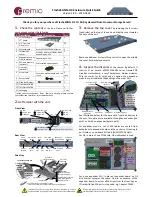
321
kilobyte (KB):
A unit of data storage equal to 1024 bytes. Although kilo means 1000, for
computers it refers to 1024, or 2 raised to the 10th power. See also
byte
.
L
laser disc:
Reflective-optical videodisc, recorded and read by laser light.
legacy device:
1) A peripheral device or card that does not have Plug and Play capability
built into it. 2) In networking, a device that is designed to work with proprietary
communication protocols instead of conforming to open standards.
light-emitting diode:
A semiconductor device that emits light when it receives an electric
current. Used for indicators like disk activity lights.
liquid crystal display (LCD):
A type of display that uses a liquid substance between two
transparent electrode panels. By selectively turning the electrodes on and off,
the LCD creates the images you see on the screen.
load:
To move information from a storage device (such as a CD-ROM) into memory,
making it available to the computer for processing.
local
bus:
A type of bus that connects devices directly to the microprocessor. Because
there are no wires between the CPU and the device, information is passed at a
much greater speed than through the system bus. See also
bus
.
logical
drive:
A section of a disk that is recognized by the operating system as a separate
disk drive. A system’s logical drives may differ from its physical drives. For
example, a single hard disk drive may be partitioned into two or more logical
drives.
M
macro:
A named sequence of instructions within a programming language or application.
A macro may be predefined in the language or application, or you may define
your own macros for procedures you use frequently. The macro name enables
you to call up the sequence of instructions when you need them.
main board:
See
motherboard
.
Содержание Magnia 3310
Страница 1: ......















































